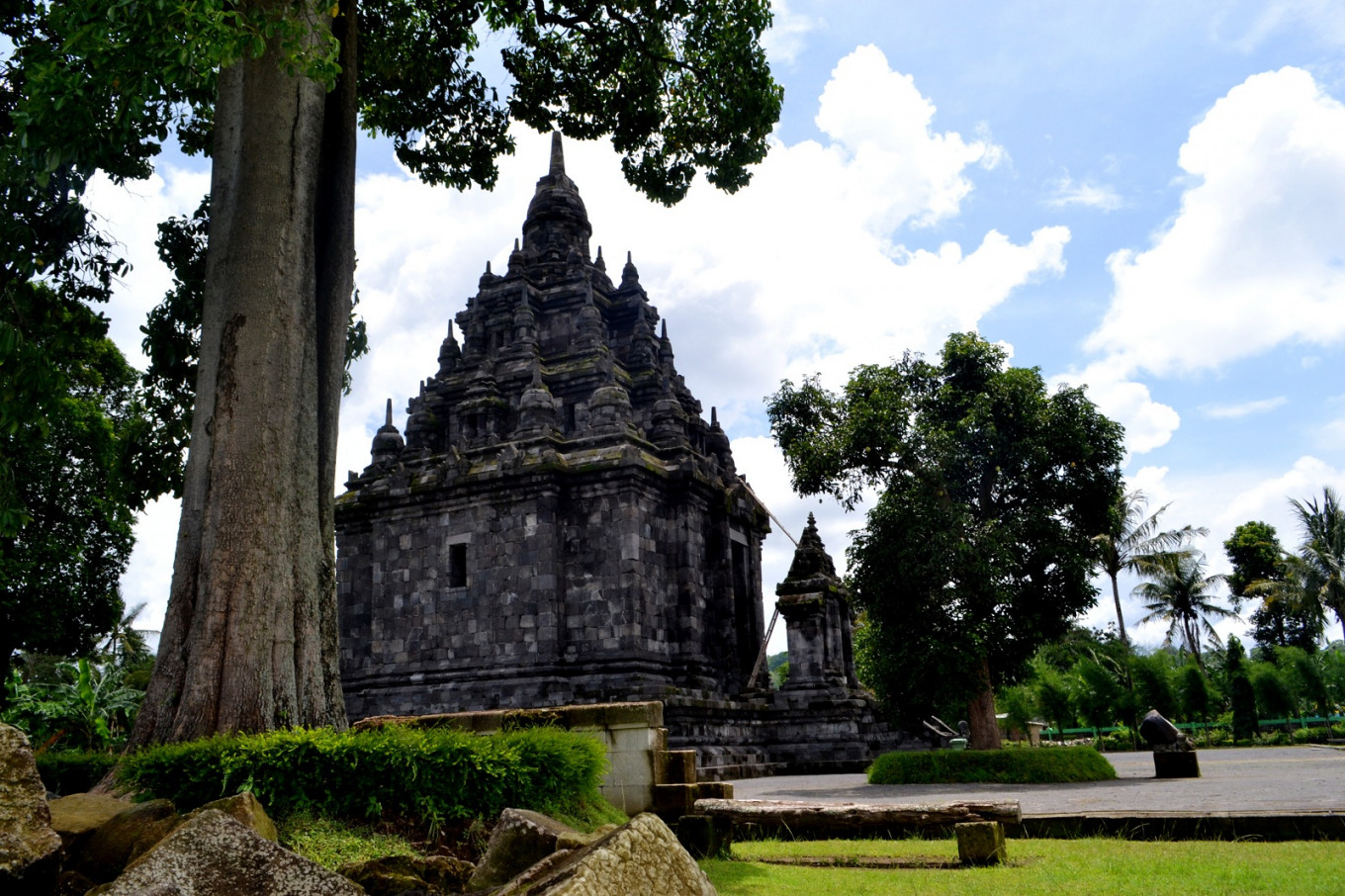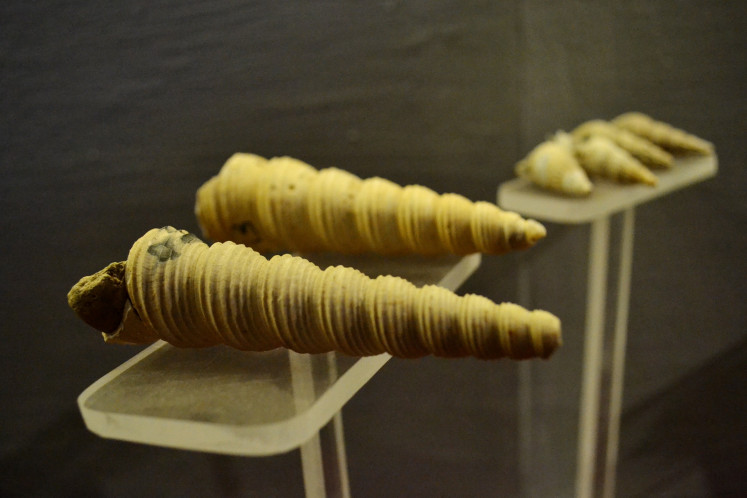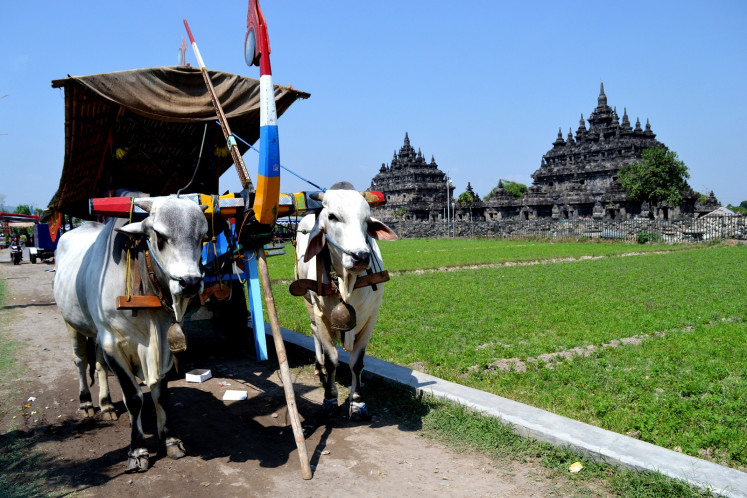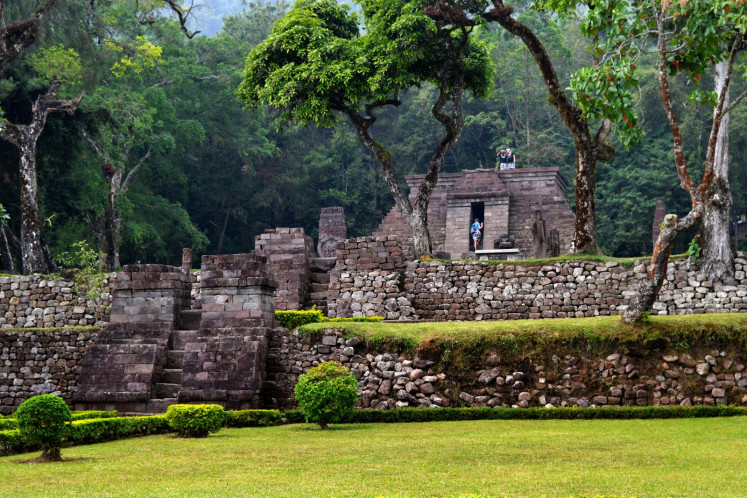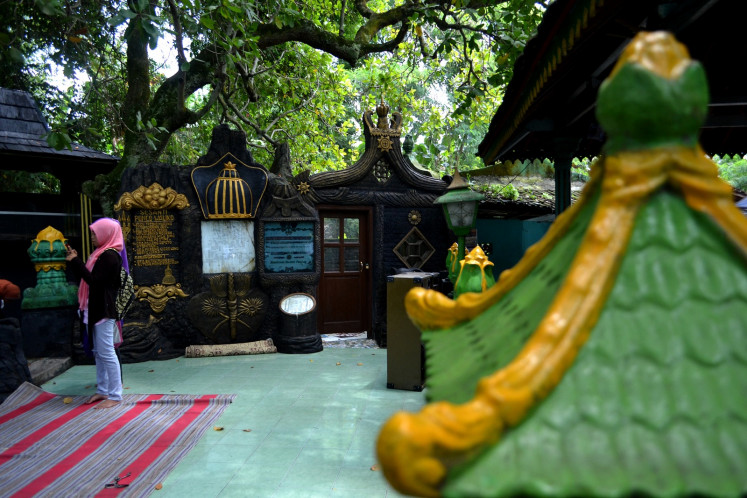Popular Reads
Top Results
Can't find what you're looking for?
View all search resultsPopular Reads
Top Results
Can't find what you're looking for?
View all search resultsStrolling through the ages in Surakarta
Here are some of the places to visit in Surakarta for history enthusiasts.
Change text size
Gift Premium Articles
to Anyone
V
isiting Surakarta, Central Java, can be like a journey through time as many destinations host traces of the past, from the pre-historic era until the end of the Mataram dynasty.
Here are some of the places to visit in Surakarta for history enthusiasts:
Sangiran
A fossil of a sea animal at Sangiran Museum. (JP/Stefanus Ajie)Sangiran is an archaeological site in Sragen, Central Java, some 17 kilometers from Surakarta. The 56-square-kilometer site has a number of museums, which are centered on the Museum Purbakala (prehistoric museum) in Krikilan subdistrict, Kalijambe, Sragen.
The museum has thousands of fossils in its collection including those of sea animals, big vertebrates like Stegodon trigonocephalusfosil, Homo erectus and prehistoric human tools.
Before Western scientists explored Sangiran, the locals called the fossils balung buto (giants’ bones). The petrified bones are indeed huge, hence the locals imagined them to be the bones of the giants as described in puppet show stories. Artist Raden Saleh introduced Sangiran to Western scientists by the end of the 19th century.
Sangiran is well known globally for its hominid fossils, which started with the finding of Pithecanthropus erectus fossils in Trinil, Ngawi regency, East Java, some 40 kilometers from Sangiran, in 1891 by Eugene Dubois. In 1934, Gustav A. von Koenigswald explored Sangiran and found some 60 fossils of Homo erectus including that of Meganthropus palaeojavanicus. Until now scientists continue to find fossils and study them in Sangiran.
Watu Kandang megalithic site
Menhir from Watu Kandang megalithic site stand among paddy fields. (JP/Stefanus Ajie)Watu Kandang is a legacy of the megalithic era located in Karangbangun subdistrict, Karanganyar regency, some 30 kilometers from Surakarta. The big rock formation is estimated to have been built around 2500-1500 BC, during the era of the Perundagian culture. The site has a strong relationship with the worshiping practices and faiths of the community groups living during the era.
Watu Kandang comprises stone enclosures that form a square or circular formation. Groups of megalithic stone structures were also found at the Plosorejo site in Gandu, Ploso Lor and Ploso Kidul hamlets, some 10 minutes’ drive from Watu Kandang. The sites are located in Matesih district and have yet to be fully excavated. Some of the rocks are located in agricultural fields.
Read also: Eight places to visit in Surakarta
Traces of Medang kingdom
A ox-drawn wagon passes in front of Plaosan temple in Klaten. (JP/Stefanus Ajie)The Medang kingdom, also known as Hindu Mataram, is a big kingdom established in Java in the eighth century. Two historical legacies that define the magnificence of this kingdom are the Borobudur and Prambanan temples. Other temple compounds of the same era can be found around Prambanan district, Klaten regency, some 48 kilometers to the west of Surakarta.
One of the compounds, namely Plaosan temple in Bugisan sub-district -- also known as the twin temples thanks to its comprising two structures, Plaosan Lor and Plaosan Kidul -- boasts a unique story. The temple was built in the ninth century by Sri Maharaja Rakai Pikatan Mpu Manuku, popularly known as Rakai Pikatan. Plaosan temple is a Buddhist temple built with the specific architecture of a Hindu temple. Based on inscriptions, the temple was built by Rakai Pikatan, who was a Hindu, for his wife Pramodawadhani, who was a Buddhist.
An interesting mix of Hindu and Buddhist architecture can also be found in Sojiwan temple in Kebon Dalem Kidul sub-district, not far from the Plaosan temple.
Temples of Majapahit’s final period
Sukuh Temple at the slope of Mount Lawu that bears witness to the era of Majapahit. (JP/Stefanus Ajie)The 15th century was the end of the Hindu-Buddhist dynasty in the archipelago, which was marked by the fall of the Majapahit kingdom. The temple compound on the slope of Mount Lawu, Karanganyar, Central Java, is a relic of that final period. The two main temples there are Sukuh and Cetho temples. Other smaller temples in the area include Kethek temple, Planggatan temple and the Menggung site.
Sukuh temple in Berjo sub-district has a year mark on its main gate, namely 1359 Saka (or 1437 AD), carved in Sengkala Memet or figures symbolized in words and images. The year marked the end of the Majapahit kingdom under the rule of Brawijaya V, whose statue can be found in the Cetho temple in Gumeng sub-district, not far from the Sukuh temple.
According to local legend, the Sukuh and Cetho temples were built by King Brawijaya V during his stay on the slopes of Mt. Lawu. He did so after he failed to reach an agreement with his son Prince Patah, whose mother was a concubine, who wanted to attack and take over Majapahit. To avoid facing his own son in a war, Brawijaya chose to leave Majapahit and go into seclusion on Mt. Lawu.
Mataram kingdoms
The exterior of Pajang Palace. (JP/Stefanus Ajie)The fall of Majapahit and the power of the Demak kingdom gave a birth to the Mataram dynasty that later led to the establishments of Surakarta and Yogyakarta. The initial traces of the dynasty can be found in the Pajang (1568–1586) palace site in Pajang sub-district, Surakarta, and Makam Haji, Sukoharjo. Only ancient building foundations and cemeteries are left at the site.
Following a series of conflicts and civil wars, in 1680 Susuhunan Amangkurat II moved the capital of the kingdom to Kartasura. Remains of the palace’s walls can still be found nowadays in Kartasura, Sukoharjo, about 12 kilometers to the west of Surakarta.
The Giyanti Treaty signed on Feb. 13, 1755, was the peak of the split in the Mataram dynasty that finally divided Mataram into two: Kasunanan Surakarta and the Yogyakarta Sultanate. In 1757, Prince Mas Said separated himself from Kasunanan Surakarta by establishing his own palace, Mangkunegaran, through the Salatiga Agreement initiated by the Dutch East Indies Company (VOC).
Surakarta is now a city while Yogyakarta has become a province. The kingdoms of the Mataram era are still well preserved as art and cultural institutions. (yun/kes)

